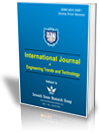A Novel Tropical Cyclone Intensity Prediction with Cyclone Classification Using Improved Dung Beetle Optimization with Deep Learning
A Novel Tropical Cyclone Intensity Prediction with Cyclone Classification Using Improved Dung Beetle Optimization with Deep Learning |
||
 |
 |
|
| © 2025 by IJETT Journal | ||
| Volume-73 Issue-3 |
||
| Year of Publication : 2025 | ||
| Author : S. Jayasree, K. R. Ananthapadmanaban |
||
| DOI : 10.14445/22315381/IJETT-V73I3P131 | ||
How to Cite?
S. Jayasree, K. R. Ananthapadmanaban, "A Novel Tropical Cyclone Intensity Prediction with Cyclone Classification Using Improved Dung Beetle Optimization with Deep Learning," International Journal of Engineering Trends and Technology, vol. 73, no. 3, pp. 448-460, 2025. Crossref, https://doi.org/10.14445/22315381/IJETT-V73I3P131
Abstract
Tropical Cyclones (TCs) contribute crucially to financial damage and loss of lives in coastal regions. As a result, TC prediction becomes a crucial research area. Estimating the intensity of TCs is beneficial for reducing and preventing the effects of natural disasters. Lately, intensity prediction remains a challenge, and TC track prediction has progressed considerably due to the complicated system of TC. Accurately estimating the TC intensity is vital for disaster management in the meteorological industry and initialization in prediction models. It is also crucial to forecasting and understanding the behaviour of TC. Moreover, cyclone classification consists of classifying cyclones according to their intensity, structure, and other meteorological features. Typically, this technique uses different criteria: organization of cloud patterns, wind speed, and central pressure. At present, the fast evolution of Deep Learning (DL) has resulted in an abundance of research using it in TC grading and TC intensity estimation. This manuscript presents a novel TC Intensity Prediction with Cyclone Classification using an Improved Dung Beetle Optimization with DL (TCIPCC-IDBODL) approach. The TCIPCC-IDBODL approach aims to predict the TC intensity and classify TC into various types. The TCIPCC-IDBODL technique follows a series of operations to estimate TC intensity and classify TC types, such as pre-processing, feature extraction, and classification. Initially, the TCIPCC-IDBODL technique pre-processes the input images via Wiener Filtering (WF)-based noise elimination and Dynamic Histogram Equalization (DHE)-based contrast enhancement. In the TCIPCC-IDBODL technique, the Squeeze-Excitation EfficientNet (SE-EfficientNet) model derives feature vectors from the pre-processed images. Moreover, the Stacked Sparse AutoEncoder (SSAE) model is used for prediction and classification. Furthermore, the hyperparameter tuning of the SSAE network is accomplished by employing the IDBO method. A range of investigations was involved in portraying the more significant achievement of the TCIPCC-IDBODL method. The performance validation of the TCIPCC-IDBODL method demonstrated a superior accuracy value of 95.12% over existing models.
Keywords
Tropical Cyclones (TCs), Weather prediction, Dung beetle optimization, Deep Learning (DL), Dynamic Histogram Equalization (DHE).
References
[1] Sarah M. Griffin, Anthony Wimmers, and Christopher S. Velden, “Predicting Short-Term Intensity Change in Tropical Cyclones Using a Convolutional Neural Network,” Weather and Forecasting, vol. 39, no. 1, pp. 177-202, 2024.
[CrossRef] [Google Scholar] [Publisher Link]
[2] Fan Meng et al., “Tropical Cyclone Intensity Probabilistic Forecasting System Based on Deep Learning,” International Journal of Intelligent Systems, vol. 2023, pp. 1-17, 2023.
[CrossRef] [Google Scholar] [Publisher Link]
[3] Lujin Li et al., “Classification of Tropical Cyclone Intensity Based on Deep Learning and YOLO V5,” Conference on Advances in Artificial Intelligence and Security, pp. 280-291, 2022.
[CrossRef] [Google Scholar] [Publisher Link]
[4] S.L. Gan et al., “Short-Term Prediction of Tropical Cyclone Track and Intensity via Four Mainstream Deep Learning Techniques,” Journal of Wind Engineering and Industrial Aerodynamics, vol. 244, 2024.
[CrossRef] [Google Scholar] [Publisher Link]
[5] Buo-Fu Chen, Yu-Te Kuo, and Treng-Shi Huang, “A Deep Learning Ensemble Approach for Predicting Tropical Cyclone Rapid Intensification,” Atmospheric Science Letters, vol. 24, no. 5, pp. 1-11, 2023.
[CrossRef] [Google Scholar] [Publisher Link]
[6] Hyeyoon Jung et al., “Tropical Cyclone Intensity Estimation through Convolutional Neural Network Transfer Learning Using Two Geostationary Satellite Datasets,” Frontiers in Earth Science, vol. 11, pp. 1-15, 2023.
[CrossRef] [Google Scholar] [Publisher Link]
[7] Wenke Wang, and Xin Wang, “The Prediction Method of Tropical Cyclone Intensity Change Based on Deep Learning,” ESS Open Archive, pp. 1-12, 2020.
[CrossRef] [Google Scholar] [Publisher Link]
[8] Liang Wang et al., “Forecasting Tropical Cyclone Tracks in the Northwestern Pacific Based on A Deep-Learning Model,” Geoscientific Model Development, vol. 16, no. 8, pp. 2167-2179, 2023.
[CrossRef] [Google Scholar] [Publisher Link]
[9] Dasol Kim, and Corene J. Matyas, “Classification of Tropical Cyclone Rain Patterns Using Convolutional Auto Encoder,” Scientific Reports, vol. 14, no. 1, 2024.
[CrossRef] [Google Scholar] [Publisher Link]
[10] Arpit Kapoor et al., “Cyclone Trajectory and Intensity Prediction with Uncertainty Quantification Using Variational Recurrent Neural Networks,” Environmental Modelling & Software, vol. 162, pp. 1-13, 2023.
[CrossRef] [Google Scholar] [Publisher Link]
[11] Wei Tian et al., “Short-Term Intensity Prediction of Tropical Cyclones Based on Multi-Source Data Fusion with Adaptive Weight Learning,” Remote Sensing, vol. 16, no. 6, pp. 1-21, 2024.
[CrossRef] [Google Scholar] [Publisher Link]
[12] Jinkai Tan et al., “Tropical Cyclone Intensity Estimation Using Himawari-8 Satellite Cloud Products and Deep Learning,” Remote Sensing, vol. 14, no. 4, pp. 1-18, 2022.
[CrossRef] [Google Scholar] [Publisher Link]
[13] Wei Tian et al., “Estimating Tropical Cyclone Intensity Using Dynamic Balance Convolutional Neural Network from Satellite Imagery,” Journal of Applied Remote Sensing, vol. 17, no. 2, 2023.
[CrossRef] [Google Scholar] [Publisher Link]
[14] Wei Tian et al., “Predicting the Intensity of Tropical Cyclones over the Western North Pacific Using Dual-Branch Spatio-Temporal Attention Convolutional Network,” Weather and Forecasting, vol. 39, no. 5, pp. 807-819, 2024.
[CrossRef] [Google Scholar] [Publisher Link]
[15] Jianbo Xu et al., “Tropical Cyclone Size Estimation Based on Deep Learning Using Infrared and Microwave Satellite Data,” Frontiers in Marine Science, vol. 9, 2022.
[CrossRef] [Google Scholar] [Publisher Link]
[16] Y. Vahidhabanu et al., “Cyclone Intensity Detection and Classification Using a Attention-Based 3D Deep Learning Model,” Proceedings of Fourth International Conference on Computing, Communications, and Cyber-Security, pp. 505-516, 2023.
[CrossRef] [Google Scholar] [Publisher Link]
[17] Chong Wang, Xiaofeng Li, and Gang Zheng, “Tropical Cyclone Intensity Forecasting Using Model Knowledge Guided Deep Learning Model,” Environmental Research Letters, vol. 19, no. 2, pp. 1-10, 2024.
[CrossRef] [Google Scholar] [Publisher Link]
[18] Chuan-Hui Zhang, and Chang-Jiang Zhang, “Rapid Intensification Forecast for Tropical Cyclone by Combining Multi-ConvLSTM Model with Infrared and Microwave Satellite Images,” Conference on Infrared, Millimeter, Terahertz Waves and Applications, vol. 12565, pp. 240-245, 2023.
[CrossRef] [Google Scholar] [Publisher Link]
[19] Chang-Jiang Zhang et al., “Deep Learning and Wavelet Transform Combined with Multi-channel Satellite Images for Tropical Cyclone Intensity Estimation,” IEEE Journal of Selected Topics in Applied Earth Observations and Remote Sensing, vol. 18, pp. 4711-4735, 2025.
[CrossRef] [Google Scholar] [Publisher Link]
[20] Wen Yang et al., “Enhancing Tropical Cyclone Intensity Estimation from Satellite Imagery through Deep Learning Techniques,” Journal of Meteorological Research, vol. 38, no. 4, pp. 652-663, 2024.
[CrossRef] [Google Scholar] [Publisher Link]
[21] Biao Tong B. et al., “Deep Learning Based Simulation of Tropical Cyclone Genesis in Northwest Pacific,” Journal of Wind Engineering and Industrial Aerodynamics, vol. 257, 2025.
[CrossRef] [Google Scholar] [Publisher Link]
[22] Jeong Hwan Kim et al., “Improvement in Forecasting Short-Term Tropical Cyclone Intensity Change and Their Rapid Intensification Using Deep Learning,” Artificial Intelligence for the Earth Systems, vol. 3, no. 2, pp. 1-16, 2024.
[CrossRef] [Google Scholar] [Publisher Link]
[23] Tianyi Lv et al., “Research on Typhoon Prediction by Integrating Numerical Simulation and Deep Learning Methods,” Atmosphere, vol. 16, no. 1, pp. 1-17, 2025.
[CrossRef] [Google Scholar] [Publisher Link]
[24] D. Yella Krishna et al., “Cyclone Intensity Estimation Using Deep Learning,” Journal of Electrical Systems, vol. 20, no. 6s, pp. 2706-2715, 2024.
[CrossRef] [Publisher Link]
[25] Xinyu Wang et al., “VQLTI: Long-Term Tropical Cyclone Intensity Forecasting with Physical Constraints,” arXiv, pp. 1-9, 2025.
[CrossRef] [Google Scholar] [Publisher Link]
[26] Manish Kumar Mawatwal, and Saurabh Das, “An End-to-End Deep Learning Framework for Cyclone Intensity Estimation in North Indian Ocean Region Using Satellite Imagery,” Journal of the Indian Society of Remote Sensing, vol. 52, no. 10, pp. 2165-2175, 2024.
[CrossRef] [Google Scholar] [Publisher Link]
[27] Yukun Xiao et al., “Sealing Strip Acoustic Performance Evaluation Using WF-VMD-Based Signal Enhancement Method,” Applied Acoustics, vol. 217, 2024.
[CrossRef] [Google Scholar] [Publisher Link]
[28] Boyina Subrahmanyeswara Rao, “Dynamic Histogram Equalization for Contrast Enhancement for Digital Images,” Applied Soft Computing, vol. 89, 2020.
[CrossRef] [Google Scholar] [Publisher Link]
[29] Umit Atila et al., “Plant Leaf Disease Classification Using Efficient Net Deep Learning Model,” Ecological Informatics, vol. 61, 2021.
[CrossRef] [Google Scholar] [Publisher Link]
[30] Ravi Teja N.V.S. Chappa, and Mohamed El-Sharkawy, “Squeeze-and-Excitation Squeeze Next: An Efficient DNN for Hardware Deployment,” 2020 10th Annual Computing and Communication Workshop and Conference (CCWC), Las Vegas, NV, USA, pp. 691-697, 2020.
[CrossRef] [Google Scholar] [Publisher Link]
[31] Yi He, Yunan Yao, and Hongsen Ou, “Status Recognition of Marine Centrifugal Pumps Based on a Stacked Sparse Auto-Encoder,” Applied Sciences, vol. 14, no. 4, pp. 1-15, 2024.
[CrossRef] [Google Scholar] [Publisher Link]
[32] Zhaodong Guo et al., “Research on Indoor Environment Prediction of Pig House Based on OTDBO–TCN–GRU Algorithm,” Animals, vol. 14, no. 6, pp. 1-20, 2024.
[CrossRef] [Google Scholar] [Publisher Link]
[33] Oluwatayomi Rereloluwa Adegboye et al., “Chaotic Opposition Learning with Mirror Reflection and Worst Individual Disturbance Grey Wolf Optimizer for Continuous Global Numerical Optimization,” Scientific Reports, vol. 14, no. 1, pp. 1-41, 2024.
[CrossRef] [Google Scholar] [Publisher Link]
[34] Kaggle, INSAT3D Infrared & Raw Cyclone Imagery (2012-2021), 2022. [Online]. Availble: https://www.kaggle.com/datasets/sshubam/insat3d-infrared-raw-cyclone-images-20132021
[35] Senthilkumar Jayaraman et al., “Enhancing Cyclone Intensity Prediction for Smart Cities Using a Deep-Learning Approach for Accurate Prediction,” Atmosphere, vol. 14, no. 10, pp. 1-16, 2023.
[CrossRef] [Google Scholar] [Publisher Link]
[36] Biao Tong et al., “Estimation of Tropical Cyclone Intensity via Deep Learning Techniques from Satellite Cloud Images,” Remote Sensing, vol. 15, no. 17, pp. 1-26, 2023.
[CrossRef] [Google Scholar] [Publisher Link]
[37] Franciskus Antonius Alijoyo et al., “Advanced Hybrid CNN-Bi-LSTM Model Augmented with GA and FFO for Enhanced Cyclone Intensity Forecasting,” Alexandria Engineering Journal, vol. 92, pp. 346-357, 2024.
[CrossRef] [Google Scholar] [Publisher Link]

